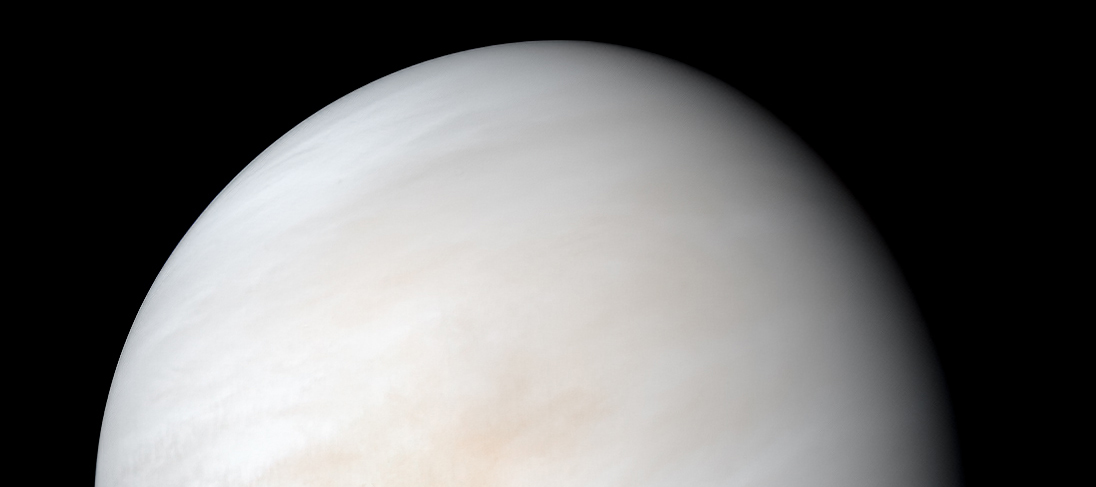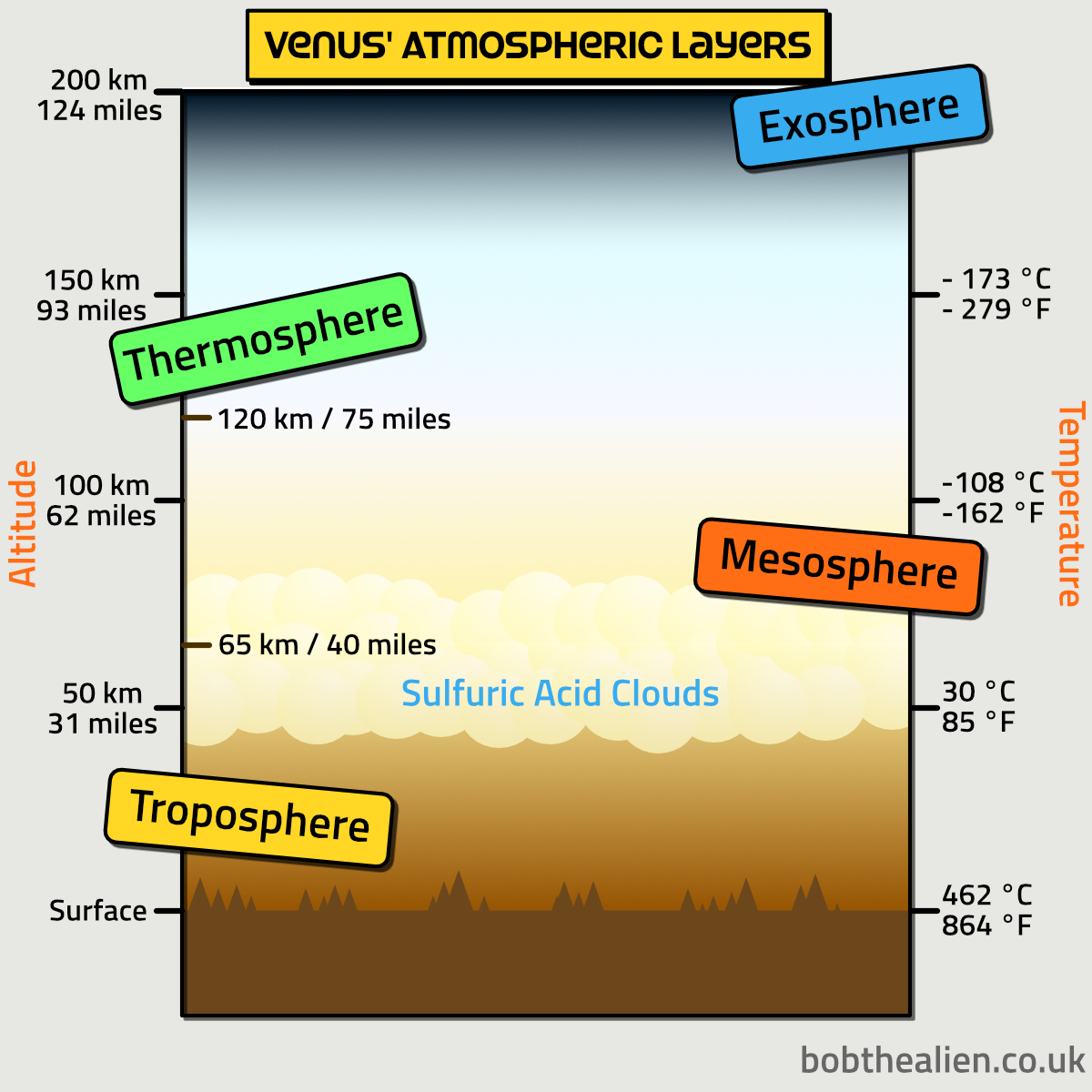Venus' Atmosphere
Venus - Earth's Evil Twin?
Venus stands out as one of the brightest and most beautiful objects in the night sky. It's so beautiful that it was named after the Roman goddess of love and beauty. In many ways, Venus is quite similar to Earth. The two planets are near neighbours in the Solar System, and they share similarities in size, mass, and density. For many years, people believed that a world of lush jungles and oceans might be hidden under its covering of thick bright clouds. But these people were very very wrong. Venus may look pretty from afar, but rather than being a tropical paradise, it is more of a hideous hellscape. It has a nasty suffocating atmosphere full of carbon dioxide that traps heat, making Venus the hottest planet in the Solar System, and its clouds are made up of toxic sulfuric acid. Venus really isn't a very welcoming planet at all and the few spacecraft that have so far managed to reach its surface have all been destroyed within minutes, cooked by its extreme heat and crushed by its atmospheric pressure.

Just like a cake, Venus’ atmosphere is made up of layers. Unlike a cake though, none of these are edible or tasty. There’s not even a layer of jam or cream in sight, and there's certainly not a cherry on top. What Venus does have though is a Troposphere, Mesosphere, Thermosphere and Exosphere. Here's an overview of them. I'd rather write about cakes though. Maybe later.
Troposphere
Extending from the surface to about 65 kilometers (40 miles) in height, the troposphere is where most of the planet’s atmospheric activity occurs. It is filled with dense carbon dioxide (CO₂), and the pressure at the surface is like being 900 meters (3,000 feet) underwater on Earth. The CO₂ is so concentrated that it behaves more like a supercritical fluid than a gas - a bit like a thick fluid gas. It also traps heat from the Sun and prevents it from escaping into space, causing surface temperatures to soar to 462 °C (864 °F). Towards the top of this layer is a sulfuric acid haze, which adds to the planet’s already toxic environment.
Mesosphere
As we ascend to heights of around 65 kilometers (40 miles), we enter Venus' mesosphere, which extends up to 120 kilometers (75 miles) above the surface. This layer is home to some of Venus’ clouds, and interestingly, temperatures in the mesosphere are warmer on the planet’s night side than on its day side. On the day side, temperatures can drop to a surprisingly chilly -108°C (-162°F), but they increase again as we go higher or transition to the night side. This odd temperature distribution is likely due to the unique atmospheric circulation and slow rotation of Venus.
Thermosphere
Beginning at around 120 kilometers (75 miles) in altitude, this layer is the uppermost part of Venus’ atmosphere. Here, temperatures can plunge to -173°C (-279°F) on the night side, making it the coldest part of the planet’s atmosphere. These temperatures are actually lower than any measured in any part of Earth's atmosphere.
Exosphere
The exosphere is where Venus’ atmosphere gradually transitions into space. It's not really a layer as such, but rather a thin region where particles are so sparse that they rarely interact with one another.
The main problem with Venus isn't the fact that it has carbon dioxide (CO₂) in its atmosphere - it's that it has way too much of it. Earth also has CO₂ in its atmosphere. Although it makes up only about 0.04% of Earth's atmosphere (compared with 96% in Venus' atmosphere), it plays an essential role in regulating the temperature on Earth. CO₂ is released into Earth's atmosphere though natural processes like volcanic eruptions, plants decaying and living organisms breathing. However, Earth has other natural processes that remove CO₂ from the atmosphere - plants turn it into oxygen during photosynthesis, and oceans and even rocks absorb it. This prevents too much of it building up in the atmosphere and leads to a happy planet Earth that doesn't overheat.
Venus may once have been a planet with similar conditions to Earth. Billions of years ago, when the Sun was younger and less hot, Venus would have been situated in a habitable zone of the Solar System. It likely had oceans of water, and may even have had lifeforms. Venus might have had natural processes that released CO₂ into its atmosphere, along with methods to absorb it too.
As the Sun became hotter over a period of billions of years, it caused the water on Venus to evaporate. The water became a vapour which began to act a bit like a blanket around Venus, preventing heat from being able to escape into space. As the temperatures on Venus increased, any existing forms of life would no longer have been able to survive. The higher temperatures would also have resulted in an increase in the amount of carbon dioxide being released into the atmosphere, especially through volcanic eruptions.
Without oceans or life forms to absorb this CO₂, the gas continued to accumulate in the atmosphere, thickening it over time. As the atmosphere thickened and the CO₂ became denser, it trapped even more heat, causing the planet to get hotter and hotter. Eventually, Venus reached a point where its atmosphere became so thick and hot that the water vapour was lost to space, leaving behind a dense, dry atmosphere filled almost entirely with CO₂ and becoming utterly inhospitable.
Clearly not satisfied with the unbearably hot and crushing conditions at its surface, Venus has even more atmosphere-related treats and surprises up its planet-sized sleeves as you go higher into its skies.
First, there's the wind. Venus experiences some of the fastest winds in the Solar System. In its upper atmosphere, wind speeds can reach up to 360 kilometres per hour (224 miles per hour), faster than the strongest hurricanes on Earth. These mega-powerful winds are driven by a phenomenon called superrotation. On Venus, the atmosphere rotates much faster than the planet itself. While the planet takes 243 Earth days to complete a single rotation, its atmosphere spins around the planet in just about four Earth days. Woosh! Closer to the surface, wind speeds drop significantly, and it's actually quite calm - but still way too hot!
And then there's the lightning - lots and lots of lightning. Scientists believe that lightning on Venus could be thousands of times more frequent than on Earth. They're not exactly sure what causes it since Venus doesn't have thunderstorms like Earth, but some seem to think that it might be due to friction between particles in the thick atmosphere. Whatever the cause, Venus is quite an electrifying place.
Finally, there's the rain, or at least a sort of rain. From Venus' thick sulfuric acid clouds, droplets of sulfuric acid form and fall, but as they descend through the planets extreme heat, they evaporate long before they can reach the ground. So, while it’s technically "raining" in the upper atmosphere, nothing ever reaches the surface.
Despite Venus being a planet of horrifying horrors, scientists believe that there is a region in its atmosphere that is surprisingly Earth-like. In fact, the conditions in this part of Venus' atmosphere might be more similar to Earth than anywhere else in the Solar System.
About 50 kilometres (31 miles) above the surface of Venus, the temperature and pressure are similar to the lower atmosphere of Earth. Scientists speculate that this region could, in theory, accommodate some form of life. Fueling this speculation is the discovery in 2020 of a gas called phosphine in Venus' clouds. On Earth, phosphine is typically associated with life, particularly the breakdown of organic matter. It also has a strong smell, like rotten fish or garlic! The puzzle for scientists is why this gas is present on Venus? And might Venus even smell a bit fishy? They aim to send spacecraft to Venus to learn more about the presence of the gas and potential life - who knows if they want to have a quick sniff of its atmosphere too.
Learning more about Venus' atmosphere is best done by visiting it, and due to the planet's proximity to Earth, sending spacecraft there isn't too tricky. The main issue is that Venus doesn't seem to take too kindly to visitors and it has a habit of destroying them. No spacecraft has entered Venus' atmosphere since 1985, and observations of the planet have usually been done while in orbit of the planet or even from Earth itself.
However, there are a number of missions to explore Venus' atmosphere planned for future years. Venus Life Finder is a private spacecraft that will attempt to detect signs of life in the atmosphere with a planned launch of 2025. India is hoping to launch Venus Orbiter Mission in 2028, dropping a kind of experiment-filled balloon into the atmosphere. Russia plans to land Venera-D on the surface of Venus after 2029, while NASA aims to send a probe called DAVINCI there sometime around 2032. One of DAVINCI's aims is to understand where Venus' atmosphere came from, why it differs from Earth and Mars, and what role water played in Venus’ past.
It's quite likely that Earth and Venus began their existences in similar ways as the Solar System formed. The two planets evolved to become twins, situated close to each other and sharing similar sizes, composition and density. While something went disastrously wrong for Venus, things appear to have worked out okay for Earth - at least for now.
The main cause for Venus' troubles is believed to be the Sun growing hotter over time, causing Venus' water to evaporate. This triggered a cycle that led to a build-up of water vapour and carbon dioxide, thickening its atmosphere eventually trapping heat from the Sun. This process is often referred to as a runaway greenhouse effect.
In billions of years, the Sun will expand as it ages. Its expansion will bring it closer to Earth, possibly absorbing Mercury and Venus in the process. As it gets closer to Earth, it will cause temperatures to rise, Earth's waters to evaporate, and may even trigger a similar runaway greenhouse effect. In the distant future, Earth's eventual fate may be similar to Venus - scorching, dry, and lifeless.
Until then though, enjoy your planet! At least it's not Venus! In fact, why not make a cake? Here’s a cake recipe. I knew I’d get back to talking about cakes somehow!
Since Venus is known for its extreme heat and volcanic past, let’s bake a Venus Lava Cake—a gooey, chocolatey treat that erupts like a volcano!
Ingredients:
- 100g (3.5 oz) of dark chocolate
- 100g (3.5 oz) of unsalted butter
- 150g (5.3 oz) of sugar
- 2 eggs
- 50g (1.75 oz) of plain flour
- A pinch of salt
- Icing sugar for dusting (optional)
Instructions:
- Preheat the oven to 200°C (400°F) and butter four small ramekins or oven-safe cups.
- Melt the chocolate and butter together in a heatproof bowl over simmering water (or carefully in the microwave). Stir until smooth.
- In a separate bowl, whisk together the egg, and sugar until light and fluffy.
- Gently fold the melted chocolate and butter into the egg mixture.
- Sift in the flour and salt, and stir until just combined.
- Pour the mixture into the prepared ramekins, filling them about three-quarters full.
- Bake in the oven for 12-14 minutes, or until the edges are firm but the center is still gooey. You want that molten lava effect!
- Let the cakes cool for a minute or two, then carefully turn them out onto plates.
- Dust with icing sugar (optional), and serve immediately to experience the molten "lava" eruption when you cut into the cake!







